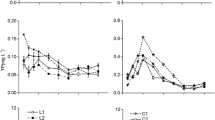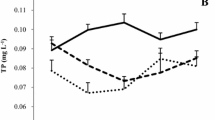Abstract
The mechanism of morphological and physiological regulation of submerged aquatic plants (Hydrilla verticillata) is influenced by spatial and environmental changes related to water depth gradients. In the present study, changes in the aquatic microcosm were explored at the depth gradients of 0.3 m, 0.6 m, 0.9 m, 1.2 m, and 1.5 m, and the depth was recognized as a critical factor for improving water quality, especially for the removal of total phosphorus (TP) and recalcitrant protein-like molecules. At 0.9 m, the removal rates of TP and protein-like substances reached 78% and 18.67%, respectively, 1.76 times and 1.28 times the rates at 0.3 m. The maximum shoot/root growth and chlorophyll (a + b) suggest photosynthesis inhibition is minimal at 1.2 m. Fluctuations in enzyme activities imply an antioxidant response to lipid peroxidation damage under different oxidative stress. The adjusted activities of glutamine synthetase (GS) and alkaline phosphatase (APA) were an adaptive nutrient utilization strategy to different water depths. Microbiological diversity analysis of biofilms indicates that community structure changes in response to water depth. Considering the growth status and nutrient removal effects, the results indicate that the optimal planting depth for H. verticillata is 0.9–1.2 m. These findings contribute to understanding water purification mechanisms in depth gradients, and support the effective rebuilding and management of submerged macrophyte communities in natural shallow lakes.







Similar content being viewed by others
Data availability
The data and materials that support the findings of this study are openly available on request.
References
Bai X, Chen K, Zhao H, Chen X (2015) Impact of water depth and sediment type on root morphology of the submerged plant Vallisneria natans. J Freshw Ecol 30(1):75–84
Bai G, Zhang Y, Yan P, Yan W, Kong L, Wang L, Wang C, Liu Z, Liu B, Ma JM, Zuo J, Li J, Bao J, Xia S, Zhou Q, Xu D, He F, Wu Z (2020) Spatial and seasonal variation of water parameters, sediment properties, and submerged macrophytes after ecological restoration in a long-term (6 year) study in Hangzhou west lake in China: submerged macrophyte distribution influenced by environmental variables. Water Res 186:116379
Brain RA, Hoberg J, Hosmer AJ, Wall SB (2012) Influence of light intensity on the toxicity of atrazine to the submerged freshwater aquatic macrophyte Elodea canadensis. Ecotoxicol Environ Saf 79:55–61
Coci M, Nicol G, Pilloni G, Schmid M, Kamst-van AM, Bodelier P, Laanbroek H (2010) Quantitative assessment of ammonia-oxidizing bacterial communities in the epiphyton of submerged macrophytes in shallow lakes. Appl Environ Microbiol 76(6):1813–1821
Cox L, Celis R, Hermosín MC, Cornejo J, Zsolnay A, Zeller K (2000) Effect of organic amendments on herbicide sorption as related to the nature of the dissolved organic matter. Environ Sci Technol 34(21):4600–4605
Dai Y, Wu J, Ma X, Zhong F, Cui N, Cheng S (2017) Increasing phytoplankton-available phosphorus and inhibition of macrophyte on phytoplankton bloom. Sci Total Environ 579:871–880
Davey M, Stals E, Panis B, Keulemans J, Swennen R (2005) High-throughput determination of malondialdehyde in plant tissues. Anal Biochem 347(2):201–207
Duguma D, Rugman-Jones P, Kaufman MG, Hall MW, Neufeld JD, Stouthamer R, Walton WE (2013) Bacterial communities associated with Culex mosquito larvae and two emergent aquatic plants of bioremediation importance. PLoS One 8(8):e72522
Eaton A, Clesceri LS, Rice EW, Greenberg AE, Franson M (2005) APHA: standard methods for the examination of water and wastewater, Centennial edn. APHA, AWWA, WEF, Washington, DC
Egert M, Tevini M (2002) Influence of drought on some physiological parameters symptomatic for oxidative stress in leaves of chives (Allium schoenoprasum). Environ Exp Bot 48(1):43–49
Fadrosh DW, Ma B, Gajer P, Sengamalay N, Ott S, Brotman RM, Ravel J (2014) An improved dual-indexing approach for multiplexed 16S rRNA gene sequencing on the Illumina MiSeq platform. Microbiome 2(1):6–13
He L, Zhu T, Wu Y, Li W, Zhang H, ZhangX CT, Ni L, HiltS (2019) Littoral slope, water depth and alternative response strategies to light attenuation shape the distribution of submerged macrophytes in a mesotrophic lake. Front Plant Sci 10:169–178
Hilt S, Gross EM (2008) Can allelopathically active submerged macrophytes stabilise clear-water states in shallow lakes? Basic Appl Ecol 9(4):422–432
Jin SQ, Zhou JB, Bao WH, Chen J, Li DD, Li Y (2017) Comparison of nitrogen and phosphorus uptake and water purification ability of five submerged macrophytes. Environ Sci 38(1):156–161
Kobayashi JT, Thomaz SM, Pelicice FM (2008) Phosphorus as a limiting factor for Eichhornia crassipes growth in the upper Parana River floodplain. Wetlands 28(4):905–913
Kuiper JJ, Verhofstad MJ, Louwers EL, Bakker ES, Brederveld RJ, Gerven LP, Jansen AB, Klein JJ, Mooij WM (2017) Mowing submerged macrophytes in shallow lakes with alternative stable states: battling the good guys? Environ Manag 59(4):619–634
Lauridsen TL, Jensen JP, Jeppesen E, Søndergaard M (2003) Response of submerged macrophytes in Danish lakes to nutrient loading reductions and biomanipulation. Hydrobiologia 506(1-3):641–649
Li B, Gu B, Yang Z, Zhang T (2018) The role of submerged macrophytes in phytoremediation of arsenic from contaminated water: a case study on Vallisneria natans (Lour.) Hara. Ecotox Environ Safe 165:224–231
Li C, Wang M, Luo X, Liang L, Han X, Lin X (2019) Accumulation and effects of uranium on aquatic macrophyte Nymphaea tetragona Georgi: potential application to phytoremediation and environmental monitoring. J Environ Radioact 198:43–49
Li Q, Gu P, Ji X, Li H, Zhang J, Zheng Z (2020a) Response of submerged macrophytes and periphyton biofilm to water flow in eutrophic environment: Plant structural, physicochemical and microbial properties. Ecotox Environ Safe 189:109990
Li H, Li Q, Luo X, Fu J, Zhang J (2020b) Responses of the submerged macrophyte Vallisneria natans to a water depth gradient. Sci Total Environ 701:134944
Liu H, Liu G, Xing W (2020) Functional traits of submerged macrophytes in eutrophic shallow lakes affect their ecological functions. Sci Total Environ:143332
Ning D, Huang Y, Pan R, Wang F, Wang H (2014) Effect of eco-remediation using planted floating bed system on nutrients and heavy metals in urban river water and sediment: a field study in China. Sci Total Environ 485:596–603
Pilar-izquierdo M, Ortega N, Perez-mateos M, Bousto M (2012) Barley seed coating with free and immobilized alkaline phosphatase to improve P uptake and plant growth. J Agric Sci 150(6):691–701
Ritchie RJ (2018) Measurement of chlorophylls a and b and bacteriochlorophyll a in organisms from hypereutrophic auxinic waters. J Appl Phycol 30(6):3075–3087
Roberts E, Kroker J, Körner S, Nicklisch A (2003) The role of periphyton during the re-colonization of a shallow lake with submerged macrophytes. Hydrobiologia 506(1-3):525–530
Schutten J, Dainty J, Davy A (2004) Wave-induced hydraulic forces on submerged aquatic plants in shallow lakes. Ann Bot-London 93(3):333–341
Shafiullah M, Lacroix CR (2013) Comparative leaf development of aerial and aquatic growth forms of Myriophyllum aquaticum. Botany 91(7):421–430
Søndergaard M, Phillips G, Hellsten S, Kolada A, Ecke F, Mäemets H, Mjelde M, Azzella MM, Oggioni A (2013) Maximum growing depth of submerged macrophytes in European lakes. Hydrobiologia 704(1):165–177
Sridhar K, Bärlocher F, Krauss GJ, Krauss G (2005) Response of aquatic hyphomycete communities to changes in heavy metal exposure. Int Rev Hydrobiol 90(1):21–32
Stephan U, Gutknecht D (2002) Hydraulic resistance of submerged flexible vegetation. J Hydrol 269(1-2):27–43
Tsikas D (2017) Assessment of lipid peroxidation by measuring malondialdehyde (MDA) and relatives in biological samples: analytical and biological challenges. Anal Biochem 524:13–30
Walsby AE (1997) Numerical integration of phytoplankton photosynthesis through time and depth in a water column. New Phytol 136(2):189–209
Wang ZQ, Yuan YZ, Ou JQ, Lin QH, Zhang CF (2007) Glutamine synthetase and glutamate dehydrogenase contribute differentially to proline accumulation in leaves of wheat (Triticum aestivum) seedlings exposed to different salinity. J Plant Physiol 164(6):695–701
Wang Q, Yang ZC, Chai B, Cheng S, Lu XH, Bai XF (2016) Heterogeneous catalytic ozonation of natural organic matter with goethite, cerium oxide and magnesium oxide. RSC Adv 6(18):14730–14740
Xian L, Zhang Y, Cao Y, Wan T, Gong Y, Dai C, Ochieng WA, Nasimiyu AT, Li W, Liu F (2020) Glutamate dehydrogenase plays an important role in ammonium detoxification by submerged macrophytes. Sci Total Environ:137859
Xiao Y, Wang YL, Gao SX, Sun C, Zhou ZY (2007) Chemical composition of Hydrilla verticillata (L. f.) Royle in Taihu Lake. J Chem 25(5):661–665 (in Chinese)
Xie S, Su S, Dai SY, Yuan JS (2013) Efficient coagulation of microalgae in cultures with filamentous fungi. Algal Res 2(1):28–33
Yan H, Liu R, Liu Z, Wang X, Luo W, Sheng L (2015) Growth and physiological responses to water depths in Carex schmidtii Meinsh. PLoS One 10(5)
Ye C, Yu HC, Kong HN, Song XF, Zou GY, Xu QJ, Liu J (2009) Community collocation of four submerged macrophytes on two kinds of sediments in Lake Taihu, China. Ecol Eng 35(11):1656–1663
Zhang K, Cao C, Zhou X, Zheng F, Sun Y, Cai Z, Fu J (2018) Pilot investigation on formation of 2,4,6-trichloroanisole via microbial O-methylation of 2,4,6-trichlorophenol in drinking water distribution system: an insight into microbial mechanism. Water Res 131:11–21
Zhao CC, Xie HJ, Xu JT, Xu XL, Zhang J, Hu Z, Wang JM (2015) Bacterial community variation and microbial mechanism of triclosan (TCS) removal by constructed wetlands with different types of plants. Sci Total Environ 505:633–639
Zhou YQ, Jeppesen E, Zhang YL, Shi K, Liu XH, Zhu GW (2016) Dissolved organic matter fluorescence at wavelength 275/342 nm as a key indicator for detection of point-source contamination in a large Chinese drinking water lake. Chemosphere 144:503–509
Zhu GT, Li W, Zhang M, Ni LY, Wang SR (2012) Adaptation of submerged macrophytes to both water depth and flood intensity as revealed by their mechanical resistance. Hydrobiologia 696(1):77–93
Funding
The study was supported by the National Science Foundation of China (51308127) and the Major Science and Technology Program for Water Pollution Control and Treatment (2012ZX07103-004).
Author information
Authors and Affiliations
Contributions
Huimin Li: Conducting experiments, data analysis, writing—original draft preparation. Yaguang Li: Data curation, investigation, resources. Deying Huang: Formal analysis, conceptualization, writing—review and editing. Liu Zhang: Methodology, investigation, formal analysis. Jilai Lu: Methodology and investigation. Jibiao Zhang: Supervision.
Corresponding author
Ethics declarations
Ethics approval and consent to participate
We declare that we do not have human participants, human data, or human tissue involved in the study.
Consent for publication
We do not have any individual person’s data in any form.
Competing interests
The authors declare no competing interests.
Additional information
Responsible Editor: Diane Purchase
Publisher’s note
Springer Nature remains neutral with regard to jurisdictional claims in published maps and institutional affiliations.
Supplementary Information
ESM 1
(DOCX 452 kb).
Rights and permissions
About this article
Cite this article
Li, H., Li, Y., Huang, D. et al. The response mechanism of Hydrilla verticillata and leaf epiphytic biofilms to depth and nutrient removal. Environ Sci Pollut Res 28, 49032–49041 (2021). https://doi.org/10.1007/s11356-021-14131-x
Received:
Accepted:
Published:
Issue Date:
DOI: https://doi.org/10.1007/s11356-021-14131-x




